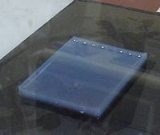
Molecular weight size marker
Encyclopedia
A molecular weight size marker is used to identify the approximate size of a molecule run on a gel
, using the principle that molecular weight is inversely proportional to migration rate through a gel matrix. Therefore when used in gel electrophoresis, markers effectively provide a logarithmic scale by which to estimate the size of the other fragments (providing the fragment sizes of the marker are known). These markers can be composed either of different proteins of known size, or nucleic acid
s of different sizes. Markers are loaded in lanes adjacent to samples lanes before the commencement of the run.
Protein or DNA markers with pre-determined fragment sizes and concentrations are commercially available. These can be run in either agarose or polyacrylamide gels.
of the Lambda phage
following digestion using the restriction enzyme
HindIII
. This produces an array of fragments ranging from 125 to 23,125 base pairs. (Actual fragment sizes are: 23130, 9416, 6557, 4361, 2322, 2027, 564, and 125 bp.)
Commercial DNA markers are usually supplied with the loading dye included in a mix, due to the difficulty of visualizing DNA during electrophoresis. Commonly used are the dye pairs xylene cyanol
and bromophenol blue
; these migrate at approximately the same rate as DNA fragments 4000 and 500 base pairs in length respectively in a 1% agarose gel. Cresol red
and orange G
can also be used for this purpose; they migrate at approximately the same rate as DNA fragments 125 and 50 base pairs respectively under the same conditions. These dyes often exhibit different colours depending on the pH of the buffer used during the run.
Gel electrophoresis
Gel electrophoresis is a method used in clinical chemistry to separate proteins by charge and or size and in biochemistry and molecular biology to separate a mixed population of DNA and RNA fragments by length, to estimate the size of DNA and RNA fragments or to separate proteins by charge...
, using the principle that molecular weight is inversely proportional to migration rate through a gel matrix. Therefore when used in gel electrophoresis, markers effectively provide a logarithmic scale by which to estimate the size of the other fragments (providing the fragment sizes of the marker are known). These markers can be composed either of different proteins of known size, or nucleic acid
Nucleic acid
Nucleic acids are biological molecules essential for life, and include DNA and RNA . Together with proteins, nucleic acids make up the most important macromolecules; each is found in abundance in all living things, where they function in encoding, transmitting and expressing genetic information...
s of different sizes. Markers are loaded in lanes adjacent to samples lanes before the commencement of the run.
Protein or DNA markers with pre-determined fragment sizes and concentrations are commercially available. These can be run in either agarose or polyacrylamide gels.
DNA markers
A commonly used DNA molecular weight marker is the genomeGenome
In modern molecular biology and genetics, the genome is the entirety of an organism's hereditary information. It is encoded either in DNA or, for many types of virus, in RNA. The genome includes both the genes and the non-coding sequences of the DNA/RNA....
of the Lambda phage
Lambda phage
Enterobacteria phage λ is a temperate bacteriophage that infects Escherichia coli.Lambda phage is a virus particle consisting of a head, containing double-stranded linear DNA as its genetic material, and a tail that can have tail fibers. The phage particle recognizes and binds to its host, E...
following digestion using the restriction enzyme
Restriction enzyme
A Restriction Enzyme is an enzyme that cuts double-stranded DNA at specific recognition nucleotide sequences known as restriction sites. Such enzymes, found in bacteria and archaea, are thought to have evolved to provide a defense mechanism against invading viruses...
HindIII
HindIII
HindIII is a type II site-specific deoxyribonuclease restriction enzyme isolated from Haemophilus influenzae that cleaves the palindromic DNA sequence AAGCTT in the presence of the cofactor Mg2+ via hydrolysis....
. This produces an array of fragments ranging from 125 to 23,125 base pairs. (Actual fragment sizes are: 23130, 9416, 6557, 4361, 2322, 2027, 564, and 125 bp.)
Commercial DNA markers are usually supplied with the loading dye included in a mix, due to the difficulty of visualizing DNA during electrophoresis. Commonly used are the dye pairs xylene cyanol
Xylene cyanol
Xylene cyanol can be used as a colour marker to monitor the process of agarose gel electrophoresis and polyacrylamide gel electrophoresis. Bromophenol blue and orange G can also be used for this purpose.-Migration speed:...
and bromophenol blue
Bromophenol blue
Bromophenol blue is used as an acid-base indicator, a color marker and a dye.-Acid-base indicator:As an acid-base indicator its useful range lies between pH 3.0 and 4.6...
; these migrate at approximately the same rate as DNA fragments 4000 and 500 base pairs in length respectively in a 1% agarose gel. Cresol red
Cresol Red
Cresol Red is a triarylmethane dye frequently used for monitoring the pH in aquaria.-pH indicator:-Molecular biology:...
and orange G
Orange G
Orange G or orange gelb is a synthetic azo dye used in histology in many staining formulations. It usually comes as a disodium salt. It has the appearance of orange crystals or powder.-Staining:...
can also be used for this purpose; they migrate at approximately the same rate as DNA fragments 125 and 50 base pairs respectively under the same conditions. These dyes often exhibit different colours depending on the pH of the buffer used during the run.

